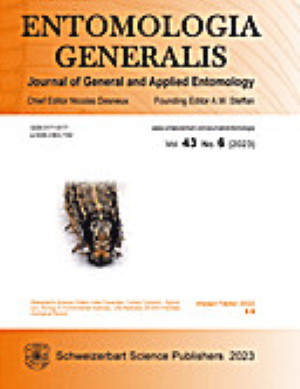比较 Vespa velutina 和 Vespa crabro 的巢化学特征:探测入侵大黄蜂物种的潜在工具
IF 4.6
1区 农林科学
Q1 ENTOMOLOGY
引用次数: 0
摘要
在打击外来入侵物种的斗争中,及时报告对于监测其扩散和应对入侵至关重要。这一点在 Vespa velutina nigrithorax 的案例中表现得尤为明显,这是一种对生态、经济和公共健康有重大影响的入侵大黄蜂物种。V. velutina 蜂群的报告通常较晚或可疑,因为它们是在秋末或冬季蜂群完成其周期后发现被遗弃的巢穴。在某些情况下,被遗弃的 V. velutina 蜂群可能会被误认为是本地欧洲大黄蜂 Vespa crabro 的巢。核实一个巢是否属于 V. velutina 可能是监测其存在和扩展的基础。因此,找到一种可靠的方法,将废弃的巢正确地归属于其确切的物种,对于管理这种入侵威胁非常重要。在这些大黄蜂中,巢材料的特点是混合了能反映其居住者的化学物质,可用于物种鉴定。在这里,我们利用气相色谱-质谱联用技术研究了 V. velutina 和 V. crabro 巢的化学特征之间的差异,首次确定了后者的巢化学特征。在鉴定出的 43 种化合物中,有两种化合物是蟹蛙独有的,另外两种化合物只在绒螯蟹巢穴中发现。这些鉴别化合物为识别被遗弃大黄蜂巢的物种提供了诊断工具,尤其是当不确定的报告来自入侵前线或尚未入侵的地区时。本文章由计算机程序翻译,如有差异,请以英文原文为准。
Comparing the nest chemical profile of Vespa velutina and Vespa crabro: a potential tool to detect invasive hornet species
In the fight against invasive alien species, timely reporting is essential to monitor their spread and face the invasion. This is particularly evident in the case of Vespa velutina nigrithorax, an invasive hornet species with a significant ecological, economic, and public health impact. V. velutina colony reports are often late or dubious, as they are represented by the discovery of abandoned nests found in late autumn or winter when the colony has completed its cycle. Abandoned colonies of V. velutina might be in some cases misidentified with nests of the native European hornet Vespa crabro. Verifying whether a nest belongs to V. velutina could be fundamental for monitoring its presence and expansion. Thus, a reliable method to correctly assign an abandoned nest to its exact species would be important for the management of this invasive threat. In these hornets, the nest material is characterized by a blend of chemical compounds that reflects its inhabitants and could be used for species identification. Here, by using gas-chromatography coupled with mass-spectrometry, we investigated the differences between the chemical signature of V. velutina and V. crabro nests, characterizing for the first time the nest chemical profile of the latter. Among the identified 43 compounds, two compounds were unique to V. crabro, and another two were found only in V. velutina nests. These discriminant compounds provide a diagnostic tool for the species identification of abandoned hornet nests, especially when uncertain reports come from areas on the invasion front or not yet invaded.
求助全文
通过发布文献求助,成功后即可免费获取论文全文。
去求助
来源期刊

Entomologia Generalis
生物-昆虫学
CiteScore
7.10
自引率
18.80%
发文量
72
审稿时长
>12 weeks
期刊介绍:
Its scope covers all aspects of basic and applied research dealing with insects and more broadly with arthropods inhabiting wild, agricultural and/or urban habitats. The journal also considers research integrating various disciplines and issues within the broad field of entomology and ecology.
Entomologia Generalis publishes high quality research articles on advances in knowledge on the ecology and biology of arthropods, as well as on their importance for key ecosystems services, e.g. as biological control and pollination. The journal devotes special attention to contributions providing significant advances (i) on the fundamental knowledge and on sustainable control strategies of arthropod pests (including of stored products) and vectors of diseases, (ii) on the biology and ecology of beneficial arthropods, (iii) on the spread and impact of invasive pests, and (iv) on potential side effects of pest management methods.
Entomologia Generalis welcomes review articles on significant developments in the field of entomology. These are usually invited by the editorial board, but proposals may be sent to the Editor-in-Chief for preliminary assessment by the editorial board before formal submission to the journal. The journal also considers comments on papers published in Entomologia Generalis, as well as short notes on topics that are of broader interest.
 求助内容:
求助内容: 应助结果提醒方式:
应助结果提醒方式:


